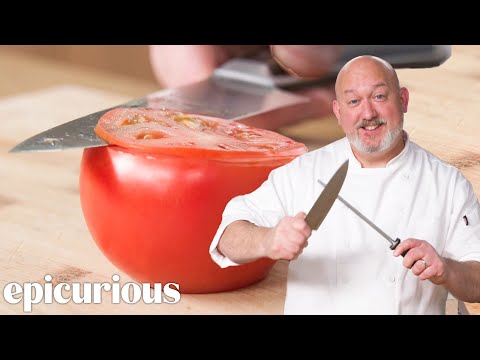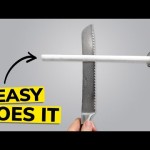
25b708e363e9599fd899bcd57b4062ea
Having a sharp knife is essential for any kitchen. Whether you’re a professional chef or a home cook, having a sharp knife can make all the difference in the quality of your food preparation. But how do you keep your knives sharp? In this article, we’ll discuss the basics of sharpening knives and what you need to know to keep your knives in top condition. We’ll cover the different types of sharpening tools, the best techniques for sharpening, and how to maintain your knives for optimal performance.
What are the proper procedures for sharpening knives
Sharpening knives is an important part of kitchen maintenance. Dull knives can be dangerous and can make cutting and slicing difficult. To ensure that your knives are always sharp and safe to use, it is important to follow the proper procedures for sharpening them.
Gather the Necessary Tools
The first step in sharpening a knife is to gather the necessary tools. You will need a sharpening stone, a honing steel, and a cloth. A sharpening stone is a flat stone with a rough surface that is used to sharpen the blade of the knife. A honing steel is a metal rod that is used to realign the blade of the knife. A cloth is used to clean the blade of the knife after sharpening.
Sharpen the Knife
Once you have gathered the necessary tools, you can begin sharpening the knife. Start by placing the sharpening stone on a flat surface. Hold the knife at a 20-degree angle and move it across the stone in a back-and-forth motion. Make sure to keep the angle consistent throughout the sharpening process. After a few passes, flip the knife over and repeat the process on the other side.
Hone the Knife
Once the knife has been sharpened, it is important to hone it. To do this, hold the honing steel in one hand and the knife in the other. Place the blade of the knife against the honing steel and move it in a back-and-forth motion. Make sure to keep the angle consistent throughout the honing process.
Clean the Knife
After sharpening and honing the knife, it is important to clean it. Use a damp cloth to wipe away any metal shavings that may have accumulated on the blade. Once the blade is clean, dry it with a clean cloth.
Conclusion
Sharpening knives is an important part of kitchen maintenance. To ensure that your knives are always sharp and safe to use, it is important to follow the proper procedures for sharpening them. Gather the necessary tools, sharpen the knife, hone the knife, and clean the knife. By following these steps, you can keep your knives sharp and safe to use.
What are the basics of sharpening
Sharpening is an essential skill for anyone who works with knives, scissors, or other cutting tools. It is important to understand the basics of sharpening in order to keep your tools in top condition and ensure that they are safe to use. Sharpening involves removing small amounts of metal from the blade of a tool in order to create a sharp edge. This process can be done by hand or with the help of a sharpening stone, sharpening steel, or other sharpening device.
Sharpening Stones are the most common tool used for sharpening.
They come in a variety of shapes and sizes and are made from different materials such as diamond, ceramic, and natural stones. Sharpening stones are used to remove small amounts of metal from the blade of a tool in order to create a sharp edge. The stones are usually used in combination with a lubricant such as oil or water.
Sharpening Steels are another type of sharpening tool. They are usually made from steel and have a long, cylindrical shape. Sharpening steels are used to hone the edge of a blade by removing small amounts of metal. They are usually used in combination with a lubricant such as oil or water.
Sharpening Devices are another type of sharpening tool. These devices are usually electric and use a rotating wheel or belt to sharpen the blade of a tool. They are often used in combination with a lubricant such as oil or water.
Sharpening Techniques are the methods used to sharpen a blade. Different techniques can be used depending on the type of tool being sharpened and the desired result. Common sharpening techniques include honing, stropping, and polishing.
Sharpening is an important skill to have in order to keep your tools in top condition and ensure that they are safe to use. Understanding the basics of sharpening and the different tools and techniques available will help you to keep your tools sharp and in good condition.
Does knowledge of sharpening knives really matter
Sharpening knives is an important skill to have in the kitchen. It can make a huge difference in the quality of your food preparation and the safety of your kitchen. But does knowledge of sharpening knives really matter?
The answer is yes. Knowing how to sharpen a knife correctly can make a huge difference in the quality of your food preparation. A sharp knife is much easier to use and will make your food preparation much faster and more efficient. It also makes it much safer to use, as a sharp knife is less likely to slip and cause an injury.
Sharpening a knife is not a difficult task, but it does require some knowledge and practice. You need to know the correct angle to hold the knife at, the correct pressure to apply, and the correct type of sharpening stone to use. If you don’t have the right knowledge and practice, you could end up damaging your knife or making it less effective.
It is also important to know how often to sharpen your knives. Over-sharpening can damage the blade, while under-sharpening can make it less effective. Knowing the right frequency of sharpening is essential for keeping your knives in top condition.
In conclusion, knowledge of sharpening knives is essential for anyone who wants to get the most out of their kitchen knives. It is not a difficult skill to learn, but it does require some practice and knowledge. Knowing the right angle, pressure, and sharpening stone to use, as well as the right frequency of sharpening, is essential for keeping your knives in top condition.
We hope this article has been helpful in teaching you the basics of sharpening knives. Remember to always be safe when handling sharp objects and to take your time when sharpening. Goodbye and happy sharpening!















